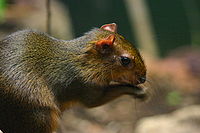- Green Acouchi
-
Green Acouchi 
Conservation status Scientific classification 
Kingdom: Animalia Phylum: Chordata Class: Mammalia Order: Rodentia Family: Dasyproctidae Genus: Myoprocta Species: M. pratti Binomial name Myoprocta pratti
Pocock, 1913The Green Acouchi, Myoprocta pratti, is a species of rodent in the acouchi genus, part of the family Dasyproctidae, from South America. Its distribution is in western Amazonia, west of the Rios Negro and Madeira, in northwestern Brazil, northeastern Peru, eastern Ecuador, southeastern Colombia, and southern Venezuela. There is substantial variation within this range, and the Green Acouchi, as currently recognized, may contain more than one species. Because the application of the scientific name acouchy, currently in use for the Red Acouchi, has historically been disputed, the name Myoprocta acouchy has sometimes been used for this species instead of Myoprocta pratti.[2]
Contents
Physiology
An adult green acouchi weighs around 1 kilogram[3] and has a short tail.[3] The acouchi is a frugivore[4] and so is prone to the dental disease caries.[4]
Behavior
Green acouchis are diurnal, surface dwelling rodents and have a complex array of behavior patterns relating to social interaction.[5] In addition, they are food hoarders, employing a scatter hoarding strategy.[5]
Reproduction
Female acouchis have an average oestrus cycle length of around 43 days[6] and have a set breeding season between autumn-spring with a 99-day gestation.[6] Females produce small litters of relatively precocial young,[7] mothers produce a 'purring' vocalisation to maintain contact with young.[7] Unusually pregnant acouchis do not specifically nest build but will instead choose a preferred nest site for the first week of lactation.[7] Mothers can become very aggressive after parturition and raise their litters in isolation;[7] weaning is extended and young remain with the mother for several weeks or months post-weaning to benefit from the mother's protection.[7]
References
- ^ Catzeflis, F., Weksler, M. & Bonvicino, C. (2008). Myoprocta pratti. In: IUCN 2008. IUCN Red List of Threatened Species. Downloaded on 5 January 2009.
- ^ Voss, R.S., Lunde, D.P. and Simmons, N.B. 2001. Mammals of Paracou, French Guiana: a Neotropical lowland rainforest fauna. Part 2. Nonvolant species. Bulletin of the American Museum of Natural History 263:1-236.
- ^ a b Weir, B.J. (1967). "The care and management of laboratory hystricomorph rodents". Lab Anim. 1: 95–104.
- ^ a b Sone, K.; Koyasu, K.; Tanaka, S.; Oda, S. (2005). "Effects of diet on the incidence of dental pathology in free living caviomorph rodents". Oral Biology 50: 323–331. doi:10.1016/j.archoralbio.2004.09.010.
- ^ a b Morris, D. (1962). "The behaviour of the green acouchi (Myoprocta pratti) with special reference to scatter hoarding". Proc Zool Soc London. 139: 701–732. doi:10.1111/j.1469-7998.1962.tb01601.x.
- ^ a b Weir, B.J. (1971). "Some observations on reproduction in the female green acouchi, Myoprocta pratti". Journal of Reproduction and Fertility 24: 193–201. doi:10.1530/jrf.0.0240193.
- ^ a b c d e Kleiman, D.G. (1972). "Maternal behaviour of the Green acouchi (Mycoprocta pratti Pocock), a South American caviomorph rodent". Behaviour 43: 48–84. doi:10.1163/156853973X00472.
Kingdom: Animalia · Phylum: Chordata · Class: Mammalia · Order: Rodentia · Suborder: Hystricomorpha · Infraorder: Hystricognathi · Parvorder: CaviomorphaDasyprocta
(Agoutis)Azara's Agouti (Dasyprocta azarae) · Coiban Agouti (Dasyprocta coibae) · Crested Agouti (Dasyprocta cristata) · Black Agouti (Dasyprocta fuliginosa) · Orinoco Agouti (Dasyprocta guamara) · Kalinowski Agouti (Dasyprocta kalinowskii) · Brazilian Agouti (Dasyprocta leporina) · Mexican Agouti (Dasyprocta mexicana) · Black-rumped Agouti (Dasyprocta prymnolopha) · Central American Agouti (Dasyprocta punctata) · Ruatan Island Agouti (Dasyprocta ruatanica)Myoprocta
(Acouchies)Categories:- IUCN Red List least concern species
- Myoprocta
- Mammals of Colombia
- Mammals of Ecuador
- Mammals of Peru
- Mammals of Brazil
- Mammals of Venezuela
- Fauna of the Amazon
Wikimedia Foundation. 2010.

